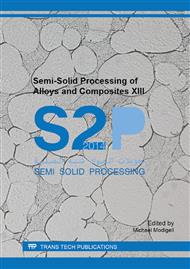[1]
Campbell F.C., Manufacturing technology for aerospace structural materials. Elsevier; (2006).
Google Scholar
[2]
Warren A.S., Developments and challenges for aluminium – A Boeing perspective. Mater Forum 2004, 28 p.24–31.
Google Scholar
[3]
Blanco M.I., The economics of wind energy. Renewable and Sustainable Energy Reviews 2009, 13, pp.1372-1382.
DOI: 10.1016/j.rser.2008.09.004
Google Scholar
[4]
Atkinson H.V. , Liu D. , (2008) Microstructural coarsening of semi-solid aluminium alloys, Materials Science and Engineering A, Volume 496, 1-2, 25, pp.439-446.
DOI: 10.1016/j.msea.2008.06.013
Google Scholar
[5]
Barnes H., (1997) Thixotropy – a review, Journal of Non-Newtonian Fluid Mechanics, 70, p.1–33.
Google Scholar
[6]
Cetin, A., Kalkanli, A., (2009) Investigation of microporosity formation mechanisms in A356 aluminium alloy castings, International Journal of Microstructure and Materials Properties , Vol. 4, No. 3, pp.377-385.
DOI: 10.1504/ijmmp.2009.031143
Google Scholar
[7]
Curle U. A., Govender G., (2010), Semi-solid rheocasting of grain refined aluminum alloy 7075, Transaction of nonferrous metals. Society of China 20, pp.832-836.
DOI: 10.1016/s1003-6326(10)60590-0
Google Scholar
[8]
Rosso M. , Peter I., Villa, R., (2008), Effects of T5 and T6 heat treatments applied to rheocast A356 parts for automotive applications, Journal of Solid State Phenomena Vol. 141-143, pp.237-242.
DOI: 10.4028/www.scientific.net/ssp.141-143.237
Google Scholar
[9]
Rosso M., Peter I., New frontiers for thixoforming, International Journal of Microstructure and Materials Properties, Vol. 8, Issue 1-2, 2013, pp.113-124.
Google Scholar
[10]
Zhen Z., Ma Qian, Ji S., Fan Z., The effects of rheo-diecasting on the integrity and mechanical properties of Mg–6Al–1Zn, , Scripta Materialia 54 (2006), 207-211, ISSN 1359-6462.
DOI: 10.1016/j.scriptamat.2005.09.032
Google Scholar
[11]
Kaufmann H., Wabusses H., Uggowitzer J., Aspects of the NRC semi-solid casting technology, Journal of Metallurgical and processing Technology, vol. 76, no1-2, pp.70-75.
Google Scholar
[12]
Rosso, M., Peter, I., Chiarmetta, G., Gattelli, I., (2010).
Google Scholar
[13]
Rosso M., Peter I., Chiarmetta G., Gatelli I., Extremely light weight rheocast components for auto motive, Diffusion and Defect Data Pt. B: Solid State Phenomena 192-193, 2012, pp.545-550.
DOI: 10.4028/www.scientific.net/ssp.192-193.545
Google Scholar
[14]
Moschini R., Molina R., Production of hollow components in high pressure die casting through the use of ceramic cores,. HTDC, Vicenza Feb (2012).
Google Scholar
[15]
Campbell J., Castings2nd edn, p.443–452; 2003, Oxford, Butterworth-Heinemann.
Google Scholar
[16]
Campbell J., Casting practice; 2004, Oxford, Butterworth Heinemann.
Google Scholar


